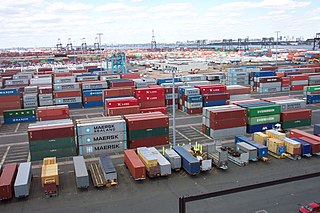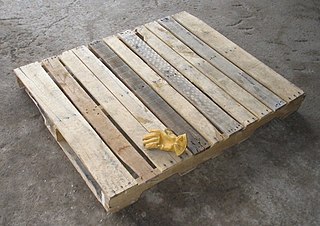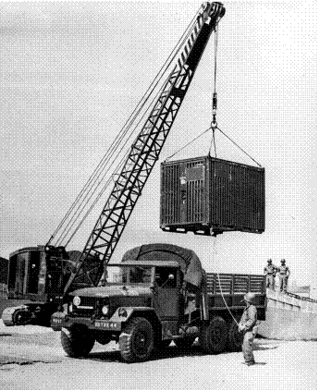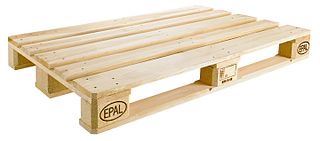
A semi-trailer truck is the combination of a tractor unit and one or more semi-trailers to carry freight. A semi-trailer attaches to the tractor with a type of hitch called a fifth wheel.

Containerization is a system of intermodal freight transport using intermodal containers. Containerization, also referred as container stuffing or container loading, is the process of unitization of cargoes in exports. Containerization is the predominant form of unitization of export cargoes today, as opposed to other systems such as the barge system or palletization. The containers have standardized dimensions. They can be loaded and unloaded, stacked, transported efficiently over long distances, and transferred from one mode of transport to another—container ships, rail transport flatcars, and semi-trailer trucks—without being opened. The handling system is mechanized so that all handling is done with cranes and special forklift trucks. All containers are numbered and tracked using computerized systems.

An intermodal container, often called a shipping container, or cargo container, (or simply "container") is a large metal crate designed and built for intermodal freight transport, meaning these containers can be used across different modes of transport – such as from ships to trains to trucks – without unloading and reloading their cargo. Intermodal containers are primarily used to store and transport materials and products efficiently and securely in the global containerized intermodal freight transport system, but smaller numbers are in regional use as well. It is like a boxcar that does not have wheels. Based on size alone, up to 95% of intermodal containers comply with ISO standards, and can officially be called ISO containers. These containers are known by many names: freight container, sea container, ocean container, container van or sea van, sea can or C can, or MILVAN, or SEAVAN. The term CONEX (Box) is a technically incorrect carry-over usage of the name of an important predecessor of the ISO containers: the much smaller steel CONEX boxes used by the U.S. Army.

A container ship is a cargo ship that carries all of its load in truck-size intermodal containers, in a technique called containerization. Container ships are a common means of commercial intermodal freight transport and now carry most seagoing non-bulk cargo.

Intermodal freight transport involves the transportation of freight in an intermodal container or vehicle, using multiple modes of transportation, without any handling of the freight itself when changing modes. The method reduces cargo handling, and so improves security, reduces damage and loss, and allows freight to be transported faster. Reduced costs over road trucking is the key benefit for inter-continental use. This may be offset by reduced timings for road transport over shorter distances.

The twenty-foot equivalent unit is a general unit of cargo capacity, often used for container ships and container ports. It is based on the volume of a 20-foot-long (6.1 m) intermodal container, a standard-sized metal box that can be easily transferred between different modes of transportation, such as ships, trains, and trucks.

In transportation, cargo refers to goods transported by land, water or air, while freight refers to its conveyance. In economics, freight refers to goods transported at a freight rate for commercial gain. The term cargo is also used in case of goods in the cold-chain, because the perishable inventory is always in transit towards a final end-use, even when it is held in cold storage or other similar climate-controlled facilities, including warehouses.

A loading gauge is a diagram or physical structure that defines the maximum height and width dimensions in railway vehicles and their loads. Their purpose is to ensure that rail vehicles can pass safely through tunnels and under bridges, and keep clear of platforms, trackside buildings and structures. Classification systems vary between different countries, and loading gauges may vary across a network, even if the track gauge is uniform.

A sidelifter is a specialised vehicle or semi-trailer used to hoist and transport ISO standard intermodal containers over longer distances.

A pallet is a flat transport structure, which supports goods in a stable fashion while being lifted by a forklift, a pallet jack, a front loader, a jacking device, or an erect crane. Many pallets can handle a load of 1,000 kg (2,200 lb). While most pallets are wooden, pallets can also be made of plastic, metal, paper, and recycled materials.

ISO 6346 is an international standard covering the coding, identification and marking of intermodal (shipping) containers used within containerized intermodal freight transport by the International Organization for Standardization (ISO). The standard establishes a visual identification system for every container that includes a unique serial number, the owner, a country code, a size, type and equipment category as well as any operational marks. The register of container owners is managed by the International Container Bureau (BIC).

A swap body, exchangeable container or interchangeable unit, is one of the types of standard freight containers for road and rail transport.
Truck classifications are typically based upon the maximum loaded weight of the truck, typically using the gross vehicle weight rating (GVWR) and sometimes also the gross trailer weight rating (GTWR), and can vary among jurisdictions.

A well car, also known as a double-stack car, is a type of railroad car specially designed to carry intermodal containers used in intermodal freight transport. The "well" is a depressed section that sits close to the rails between the wheel trucks of the car, allowing a container to be carried lower than on a traditional flatcar. This makes it possible to carry a stack of two containers per unit on railway lines wherever the structure gauge assures sufficient clearance.

A twistlock or twist lock, together with matching corner castings, as defined in norms including ISO 1161:1984, form a standardized (rotating) connector system, for connecting and securing intermodal, and predominantly ISO-standard international shipping containers. The primary uses are to securely stack containers, for locking them into place on a container ship, semi-trailer or rail carriage, and for lifting and handling by specific container-handling equipment, like straddle carriers, reach stackers, container-handling forklifts, sidelifters, and various types of container cranes.

Double-stack rail transport is a form of intermodal freight transport in which railroad cars carry two layers of intermodal containers. Invented in the United States in 1984, it is now being used for nearly seventy percent of United States intermodal shipments. Using double stack technology, a freight train of a given length can carry roughly twice as many containers, sharply reducing transport costs per container. On United States railroads, special well cars are used for double-stack shipment to reduce the needed vertical clearance and to lower the center of gravity of a loaded car. In addition, the well car design reduces damage in transit and provides greater cargo security by cradling the lower containers so their doors cannot be opened. A succession of larger container sizes have been introduced to further increase shipping productivity in the United States.

The CONEX box, a portmanteau of "Container, express", is a type of cargo container that was developed during the Korean War and was used to transport and store supplies during the Korean and Vietnam wars. It was reinvented by Malcom McLean to form the standard intermodal shipping container, often called an ISO box, after ISO 668/ISO 6346, that is used widely by container shipping companies today.

The EUR-pallet, also known as Euro-pallet or EPAL-pallet, is the standard European pallet as specified by the UIC pallet working group and the UIC 435-2 leaflet. Pallets conforming to the standardization are eligible for the European Pallet Pool (EPP), the system which allows for an exchange as "pallet for pallet".
Vehicle weight is a measurement of wheeled motor vehicles; either an actual measured weight of the vehicle under defined conditions or a gross weight rating for its weight carrying capacity.

A flat rackcontainer is a shipping container with two end walls, but without side walls and roof. Some flat racks can also be equipped with pillars. Flat rack containers are also available as stake containers with and without end walls.
![Container handling--6102[( Pictures taken in Japan )] .jpg](http://upload.wikimedia.org/wikipedia/commons/thumb/8/86/Container_handling--6102%E3%80%90_Pictures_taken_in_Japan_%E3%80%91.jpg/220px-Container_handling--6102%E3%80%90_Pictures_taken_in_Japan_%E3%80%91.jpg)


















